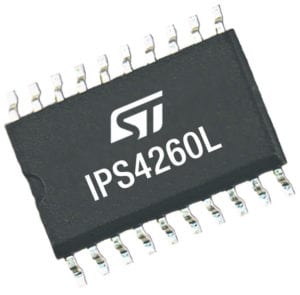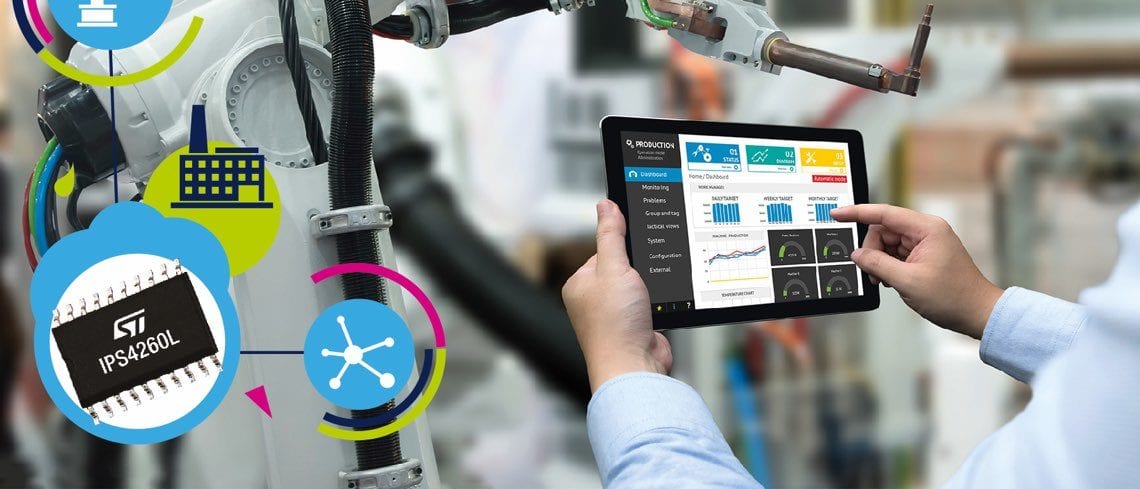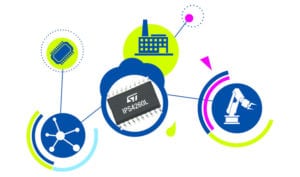The IPS4260L is our first integrated quad low-side power switch, and its recent launch enables us to better address markets and designs that tend to steer away from high-side switches. It can work in consumer or industrial applications for valves or motor control, for instance, as well as programmable logic controls, PC peripherals, or more general applications. It distinguishes itself thanks to a high-speed monolithic architecture and two diagnostic pins as well as non-dissipative overload and per-channel thermal protection, thus offering an intelligent and robust system. Its integrated design also means that engineers do not have to go with discrete solutions, but can benefit from a simpler all-in-one device.
As a quad switch, it uses four independent and protected channels to manage up to four loads, whether they be capacitive, resistive, or inductive, while its low side-aspect means that the current goes through the switch and to the ground while the load connects directly to the power supply. Europe and the Americas tend to prioritize high-side devices that switch at the power supply and connects the load to the ground. The latter tends to offer safer switching operations since the power supply doesn’t directly connect to the load. On the other hand, a low-side switching is far easier to implement, and it often allows for components with higher RDS(on), which explains why Asian manufacturers have a long history of preferring this approach and why these markets often prioritize these solutions.
However, when we decided to launch our first integrated quad low-side power switch, we wanted to undoubtedly bring something new to the table, which we did in the form of our intelligent protection and diagnostic systems.
A Smart Quad Low-Side Power Switch That Protects

Typically, intelligent protection and detection systems are present on high-side switches. Indeed, low-side discrete solutions are prevalent, but they require that these extra features use external components. We thus decided to integrate these functionalities in our desire to bring a more comprehensive device. Intelligent protection refers to the features that protect a device and the module where it is installed against a faulty load or a particular failure. For instance, we safeguard the IPS4260L against over temperatures, even in the case of a short-circuit, by selectively turning channels off if the junction temperature goes over a specific threshold.
The user can also configure the low-dissipative short-circuit protection. Indeed, an external resistor sets the overcurrent threshold as well as the internal counter for the next restart. Similarly, we embedded an under voltage lockout, which turns the device off if the power is too unstable and drops under certain levels. Furthermore, adding a very inexpensive Transient Voltage Suppressor diode that the system can share among all output channels greatly increases the switch’s demagnetization capabilities of inductive loads, on top of increasing its surge pulse robustness. Finally, we also offer Ground and VCC disconnection protection to prevent critical malfunctions.
A Smart Quad Low-Side Power Switch That Diagnoses
We also integrated a smart diagnostic architecture that uses two open drain signal to alert the microcontroller (MCU) when one of the built-in protection goes into effect. Let’s take the example of an overload, which leads to overheating, thus engaging the over-temperature protection of one or more channel. In this event, the device first protects itself by activating the intelligent built-in safeguards. It will then use both the FLT and INx signals to report the event to the MCU. Another example is the open load detection feature. If the load disconnects from the LOADx pin because of a wire break, the OL pin sends a signal to the MCU.
Developers can thus create complex algorithms to respond to various situations and program alternative behaviors to protect the design and better face unexpected events. For instance, if we go back to the low-dissipative short-circuit protection mechanism, we see that the current flow through the power stage of the IPS4260L no longer than a configured time slot and it is capped according to a threshold set by an external resistor. A flag alerts the MCU, the power stage restarts only after the configurable delay has elapsed and the system, working at a lower average temperature, determines if the problem is still there or not. As a result, an MCU getting multiple flags can, in turn, take more complex actions to respond to this issue.
A Silicon That Is IEC-61131-2 Tough With Very Little Resistance
The IPS4260L is a monolithic switch, meaning that all its features are on the silicon, which in turn signifies that the die has a larger size than if we had taken a simpler approach. However, we chose this approach because we knew that our manufacturing processes enable us to create a component that was reliable and unique. In fact, its performance is among the best for this kind of architecture since we have a typical RDS(on) of only 0.26 Ω, which means that there are minimal power losses within the switch itself, thus positively contributing to the overall efficiency of the product. Indeed, discrete low-side switches are more common because creating an all-in-one solution is a lot more complex. However, we are able to offer excellent performance and an impressive feature-set to transform the industry.
The quality and robustness of the device also transpire through some of its fundamental characteristics, such as its vast operating voltage range that goes from 8 V to 50 V. Since the part is primarily for 24 V applications, engineers know the component has enough margins to survive a significant voltage spike or a severe voltage drop. In fact, we designed and tested our new part number to meet the IEC-61131-2 standard for programmable controllers. Teams that use multiple external components from different manufacturers must go through a much more elaborate testing process to ensure that all the components they chose meet these requirements. Hence, engineers that prefer our switch already know that the IPS4260L is ready for harsh and rigorous industrial environments and that they will also have a much easier time passing the industry’s stringent certifications.
An Evaluation Board and GUI as a First Step into the IPS4260L
Teams that want to start experimenting with the IPS4260L can get the STEVAL-IFP029V1, an evaluation board that will allow you to monitor the switch’s channels, its performances, and safety features. It will enable them to program the cut-off delay time, and LEDs on the board will alert users if an event triggers the thermal or short-circuit protections. Additionally, we offer STSW-IPF029GUI, a graphical user interface that provides the option to drive the STEVAL-IFP029V1 in steady state or PWM while also offering graphical options to configure a timer that will define how often the system checks the status of the device.





